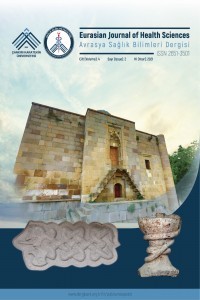Düzeltme: Çörek Otu Tohumu Esansiyel Yağının Antioksidan Etkinliğinin in vitro Yöntemlerle Araştırılması
Antioksidan aktivite, Çörek otu tohumu esansiyel yağı, Toplam fenolik madde
Düzeltme: Research on the Antioxidant Efficiacy of Black Seed Essential Oil Using by in vitro Method
___
- 1. Al-Ghamdi MS. (2001). The anti-inflammatory, analgesic and antipyretic activity of Nigella sativa. Journal of Ethnopharmacology 76: 45-48.
- 2. Al-Saleh IA, Billedo G, El-Doush II. (2006), Level of selenium, tocopherol, thymoquinone and thymol of Nigella sativa seed J Food Compos Anal 19:167-175.
- 3. Badary OA. (1999). Thymoquinone attenuates ifosfamide-induced Fanconi syndrome in rats and enhances its antitumor activity in mice. Journal of Ethnopharmacology 67:135-142.
- 4. Blois MS (1958). Antioxidant determinations by the use of stable free radical. Nature 1199-1200.
- 5. Bulca S. (2015). Çörek otunun bileşenleri ve bu yağın ve diğer bazı uçucu yağların antioksidan olarak gıda teknolojisinde kullanımı. Journal of Adnan Menderes University Agricultural Faculty 11(2):29- 36.
- 6. Burits M, Bucar F. (2000). Antioxidant activity of Nigella sativa essential oil. Phytother Res 14:323-328.
- 7. Butt AS, Nisar N, Mughal TA, Ghani N, Altaf I (2019). Anti-oxidative and anti-proliferative activities of extracted phytochemical compound thymoquinone. J Pak Med Assoc 69(10):1479-1485.
- 8. Chen X, Ahn DU (1998). Antioxidant activites of six natural phenolics against lipid oxidation induced by Fe2+ or ultraviolet light. Journal of the American Oil Chemist’s Society 75: 1717-1721.
- 9. Corpas FJ, Fernandez-Ocana A, Carreras A, Valderrama R, Luque F, Esteban FJ, Rodriguez-Serano M, Chaki M, Pedrajas JR, Sandalio LM, Del Rio LA, Barroso JB (2006). The espression of different superoxide dismutase froms is cell-type dependent in olive (Olea europaea L.) leaves. Plant Cell Physiol 47(7): 984-994.
- 10. Darakhshan S, Bidmeshki Pour A, Hosseinzadeh Colagar A, Sisakhtnezhad S (2015). Thymoquinone and its therapeutic potentials. Pharmacol Res 95-96:138-58.
- 11. Dinis TCP, Madeira VMC, Almeida LM (1994). Action of phenolic derivatives (acetaminophen, salicylate, and 5-aminosalicylate) assay inhibitors of membrane lipid peroxidation and assay peroxyl radical scavengers. Archives of Biochemistry and Biophysics 315(1): 161-169.
- 12. Ferdous AJ, Islam, SN, Ashan M, Hasan CM, Ahmed ZU. (1992). In vitro antibacterial activity of the volatile oil of Nigella sativa seeds against multiple drug resistant isolates of Shigella, V. Cholerae and E. Coli. Phytother Res 6: 137-140.
- 13. Halliwell B, Clement MV, Long LH. (2000) Hydrogen peroxide in the human body. FEBS Letter 486: 10-13.
- 14. Halliwell B, Gutteridge JMC (1990) Role of free radicals and catalytic metal ions in human disease: An overview. In: Methods in Enzymology 186: 1-85.
- 15. Juntachote T, Berghofer E (2005). Antioxidative properties and stability of ethanolic extracats of holy basil and galangal. Food Chemistry 92: 193-202.
- 16. Kiralan M (2014). Changes in volatile compounds of black cumin (Nigella Sativa L.) seed oil during thermal oxidation. International Journal of Food Properties 17:1482-1489.
- 17. Mılıauskas G, Venskutonıs PR, Van Beek TA (2004). Screening of radical scavenging activity of some medicinal and aromatic plant extracts. Food Chemisrty 85: 231-237.
- 18. Mohammed NK, Abd Manap MY, Tan CP, Muhialdin BJ, Alhelli AM, Meor Hussin AS (2016). The effects of different extraction methods on antioxidant properties, chemical composition, and thermal behavior of black seed (Nigella sativa L) Oil: Evidence-based complement. Altern. Med pp. 1-10.
- 19. Onat T, Emerk K, Sözmen EY. İnsan Biyokimyası. 2. Baskı, Palme Yayıncılık, 2006, Ankara.
- 20. Oyaizu M (1986). Studies on product of browning reaction prepared from glucose amine. Japan Journal of Nutrition 44: 307-315.
- 21. Pan Y, Zhang X, Wang H, Liang Y, Zhu J, Li H, Zhang Z, Wu Q (2007). Antioxidant potential of ethanolic extract of Polygonum cuspidatum and application in peanut oil. Food Chemistry 105: 1518-1524.
- 22. Ramadan MF (2007). Nutritional value, functional properties and nutraceutical applications of black cumin (Nigella sativa L.): an overview. International Journal of Food Science and Technology 42(10): 1208-1218.
- 23. Ramadan MF, Kroh LW, Mörsel JT (2003). Radical scavenging activity of black cumin (Nigella sativa L.), coriander (Coriandrum sativum L.), and niger (Guizotia abyssinica Cass.) crude seed oils and oil fractions. J Agric Food Chem 51:6961-6969.
- 24. Randhawa MA, Al-Ghamdı MS (2002). A review of the pharmaco-therapeutic effectes of Nigella sativa. Pakistan J Med Res 41(2): 7783. 25. Salem ML (2005). Immunomodulatory and therapeutic properties of the Nigella sativa L. seed. Int. Immunopharm 5: 1749-1770.
- 26. Shon MY, Kım TH, Sung NJ (2003). Antioxidants and free radical scavenging activity of Phellinus baumii (Phellinus of Hymenochaetaceae) extracts. Food Chemistry 82: 593-597.
- 27. Singleton VL, Rossi JA (1965). Colorimetry of total phenolics with phosphomolybdic-phosphotungstic acid reagents. American Journal of Enology and Viticulture 16: 144-158.
- 28. Thippeswamy NB, Naidu KA (2005). Antioxidant potency of cumin varieties- cumin, black cumin and bitter cumin-on antioxidant systems. European Food Reserach Technology 220: 472-476.
- 29. Uras ŞS, Silahtaroğlu S, İlçim A, Kökdil G (2010). Fatty Acid, tocopherol, mineral composition, total phenolic, flavonoid, thymoquinone content, and antioxidant activity of Nigella Sativa L. J. Fac. Pharm 39 (3): 173-186.
- 30. Vansteenhouse JL (1985). Free radicals: relation to tissue damage-a review. Vet Clin Pathol 16: 29-35.
- Yayın Aralığı: Yılda 3 Sayı
- Başlangıç: 2018
- Yayıncı: Çankırı Karatekin Üniversitesi
Abdullah Ahmed Rashad AL-JUBOORİ, Deniz ÇAKAR, Seçil AKILLI SİMSEK, Salih MADEN2
HASTANELERİN ÇOCUK GELİŞİMİ BİRİMLERİNE YÖNLENDİRİLEN EN SIK BAŞVURU NEDENLERİNİN BELİRLENMESİ
Belgin ŞEN ATASAYAR, Özge İŞERİ
Gülcan AVCI, Barış DENK, Aziz BÜLBÜL
Fatma Şeyma GÖKDEMİR, Fatma Gönül SOLMAZ, Sumer ARAS
COVID-19 tanılı yaşlılara hastalık nereden ve nasıl bulaştı?
Tahsin Barış DEĞER, Resul DOĞAN
Salgın Değişim Eğrisi Ölçeğinin Geliştirilmesi: Geçerlilik ve Güvenilirlik
Burcu ÇAKI, Zeynep GÜNGÖRMÜŞ, Sebahat KUŞLU
Yetişkin Yeme Davranışı Ölçeği: Türkçeye Uyarlama, Geçerlik ve Güvenilirlik Çalışması
Murat YÜCEL, Adnan KARAİBRAHİMOĞLU, Hikmet ORHAN
Esra ÇAVUŞOĞLU, Hülya ÖZKAYALAR, Sabire YURTSEVER, Mukadder ÇALIKOĞLU, Bahar TAŞDELEN
